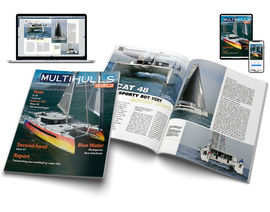Helia 44 for sell, ready to sail...
- Location :
- Le Marin, Martinique
- Year :
- 2015
A sailing area that goes from turquoise to caramel, with varied coastlines, rivers to discover and most importantly, islands with different personalities. What more could you ask for on a wonderful cruise on a multihull.
In the middle of France’s Atlantic coastline, La Rochelle has been at the center of recreational boat construction for decades. The town has no less than 5,047 spaces for boats with a huge 4,500 in the Port des Minimes, which has recently been enlarged. It has less charm than the Vieux Port, but it’s easier to accommodate multihulls. Although it has lost some of its regattas to Brittany, further north, it is still an interesting place to sail. You can discover several islands and head into the coastal rivers. There’s varied sailing, along with relatively short stages, meaning that it is a perfect family holiday destination. Even though La Rochelle has plenty of comprehensive infrastructure for welcoming multihulls, even larger ones, we cannot say the same thing about the surrounding ports. A 35-foot catamaran, or even better a folding trimaran, can slip through. For bigger craft, you will need to anchor, or for those boats that are adapted for it, you also have the option to beach your vessel.
Depending on the wind and most importantly, the tide schedule, this itinerary will need to be amended.
After getting familiar with your catamaran and stocking her up, head to the south west and take the channel, then head for the bridge to the Ile de Ré. Just to the south west of the bridge is Sablanceaux beach which is perfect for your first dip. Head under the bridge for a first river trip on the Sèvre Niortaise. Before nightfall, head west towards the Fier d’Ars and the famous Banc du Bûcheron (a sandbank which appears at low tide).
Got your sea legs back? Well, then it’s time for the 50 nautical miles towards the Ile d’Yeu. Set off early so as to avoid sailing into a headwind too soon. Magnificent beaches and picturesque restaurants await you. There are plenty of sheltered anchorages.
Only 27 nautical miles separate the island from the home of the Vendée Globe… The anchorage in front of the beach is reliable in good weather. Take your dinghy and have a look at the town which is very lively in summer.
Make the most of the good weather to take another short ocean journey and sail around the Ile de Ré. Oléron’s main port is Saint Denis in the north. A cutoff forbids entering at low tide. There are moorings outside. In good weather, it is possible to anchor outside the port of Douhet and the Saumonards Point.
Carry on exploring Oléron: you’ll be able to see Fort Boyard! Head south respecting the buoyage and discover Gatseau Cove and its turquoise waters. Opposite is Marennes Oléron, the French oyster capital. Then head north to spend the night at the Ile d’Aix. You can stay afloat at anchor or you can take the ground.
Catch the high tide to sail up the Charente river. Discover the banks and the timbers of the old ferry bridge. You can sail up, well past Rochefort – watch out for the air draft when you go under the bridges. The best place to spend the night has to be the pontoon of the Corderie Royale.
Take advantage of the falling tide to slip gently down the Charente. You can make a last stop for a meal and a swim on the Ile d’Aix before returning to base.
Getting There:
The Rivages charter base is situated at the Port des Minimes, not far from the train station. There are around 13 direct TGV trains from Paris (3h 15m trip) every day. The town also has an airport which has good connections to the UK and Ireland.
Formalities:
ID card for EU residents.
Valid passport + a visa for some countries. Check with the French consulate or French embassy in your country of residence.
Local currency: euro - 1 € = 1,13 $
Language: French
Health: usual vaccinations
When to go:
La Rochelle, and especially the Ile de Ré have a mild, temperate oceanic climate which is quasi-Mediterranean in summer. The sunshine hours here are the highest on the Atlantic coast with nearly 2,300 hours per year. There is more rain in winter but the overall average of 750mm (30”) is not excessive. The best time to sail is from May to October. The water temperature is above 20°C (68°F) from July to the end of September.
Sailing Conditions.
The main islands of Ré and Oléron generally protect the main sailing area from the Atlantic swell. The prevailing wind is usually from the west/north west. But from May to September, it tends to be a gentle north easterly, turning north west force 3 or 4 early afternoon and then dropping and turning north in the evening. The anchorages are fairly calm and the conditions are generally good after 2pm on a fairly calm sea. However, the sea is rougher when you leave the shelter of the islands, especially around the northern capes. You will notice the tidal currents but they don’t exceed two knots. Obviously for going up and down the rivers we recommend that you try and catch the tide.
Charter companies:
Surprisingly there are very few multihull charterers apart from Rivages which has recently been bought by Dream Yacht Charter. However, it is now a destination that is offered by several charter brokers.

What readers think
Post a comment
No comments to show.